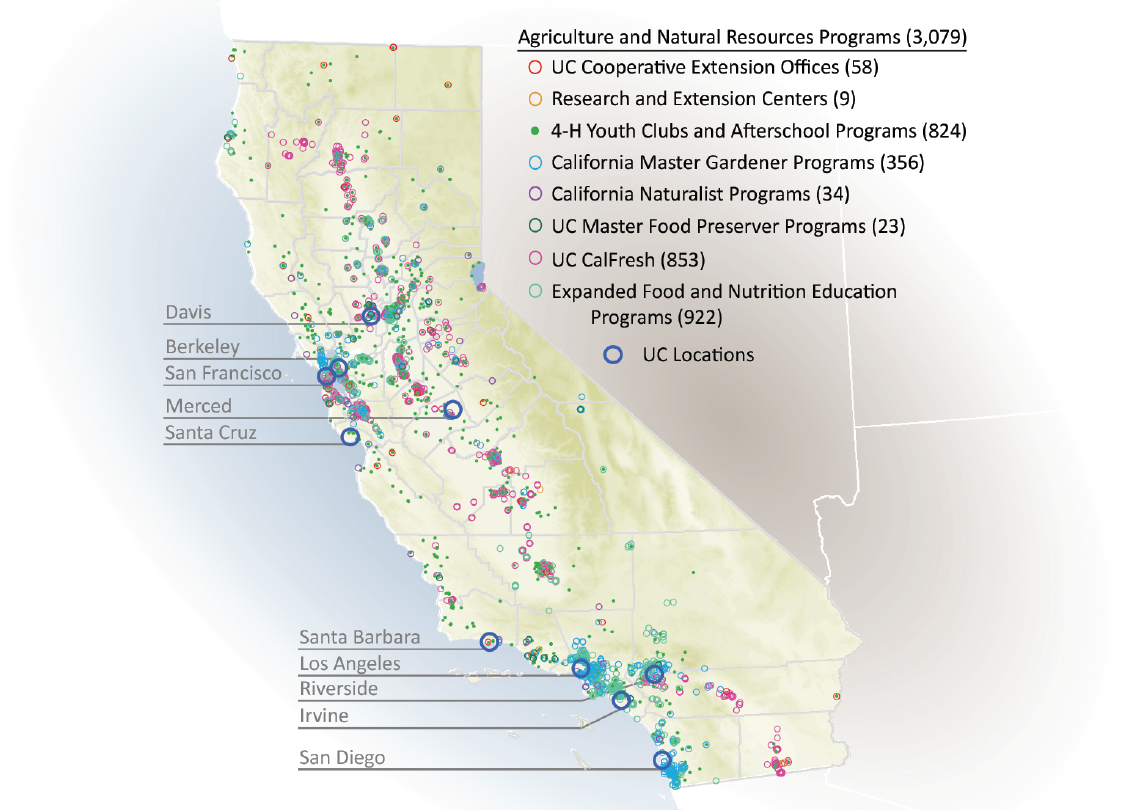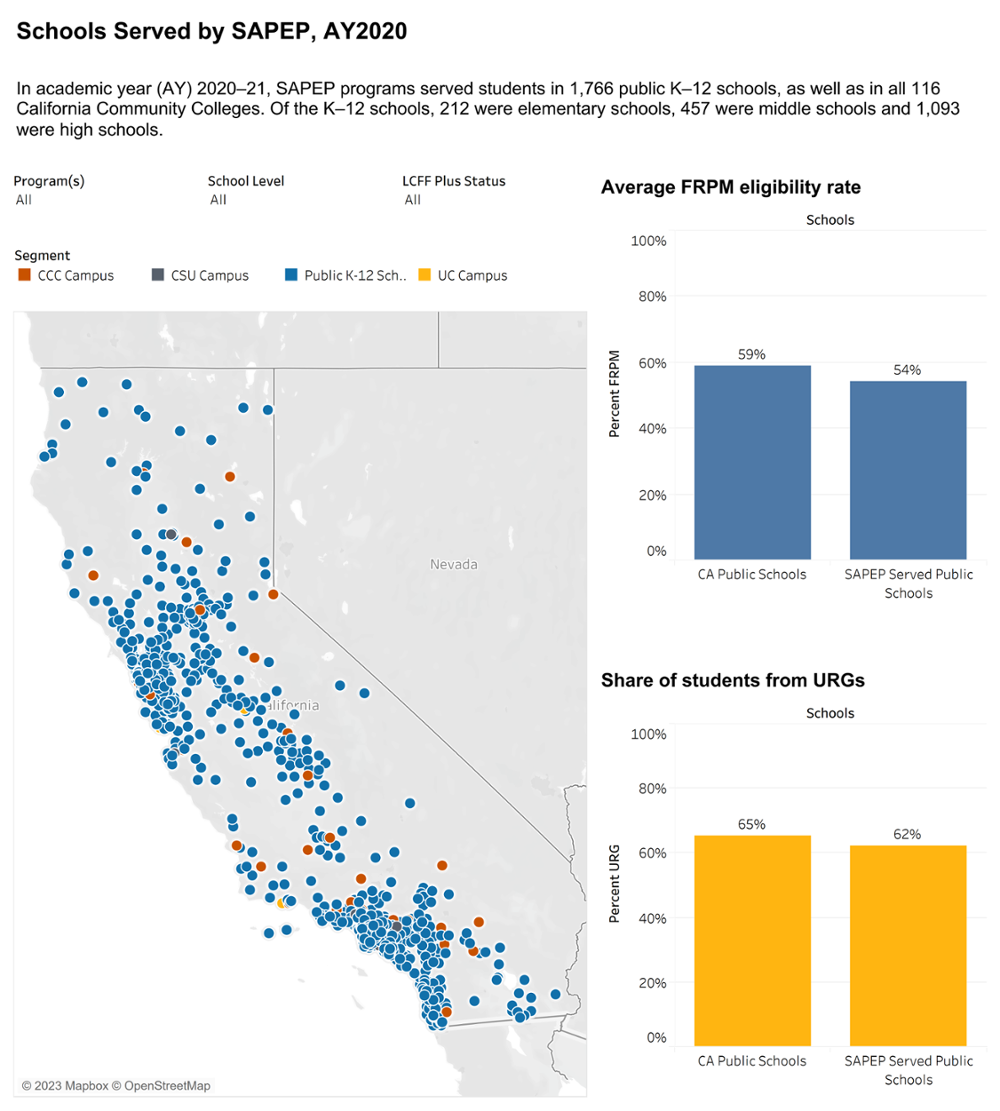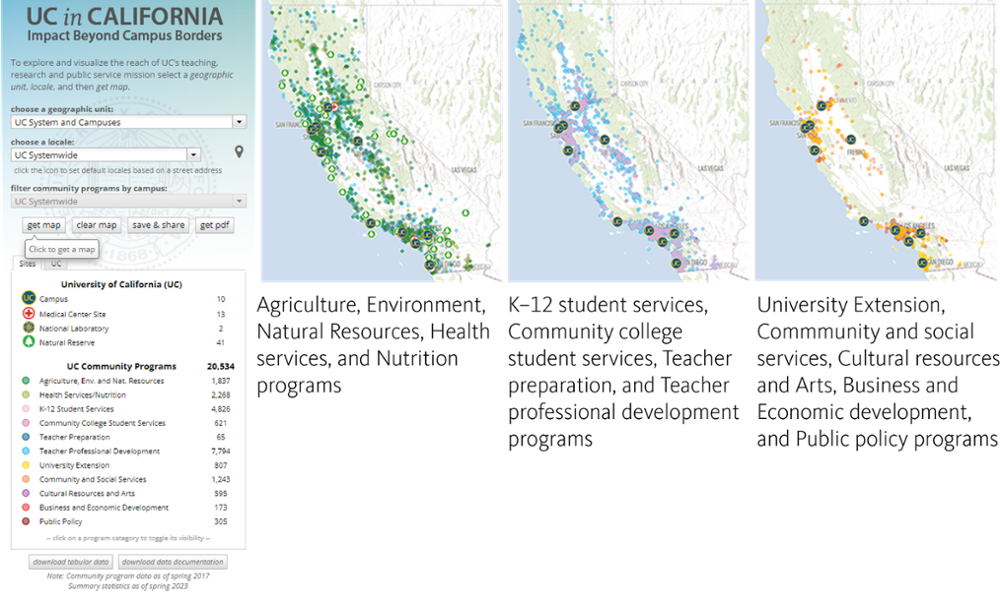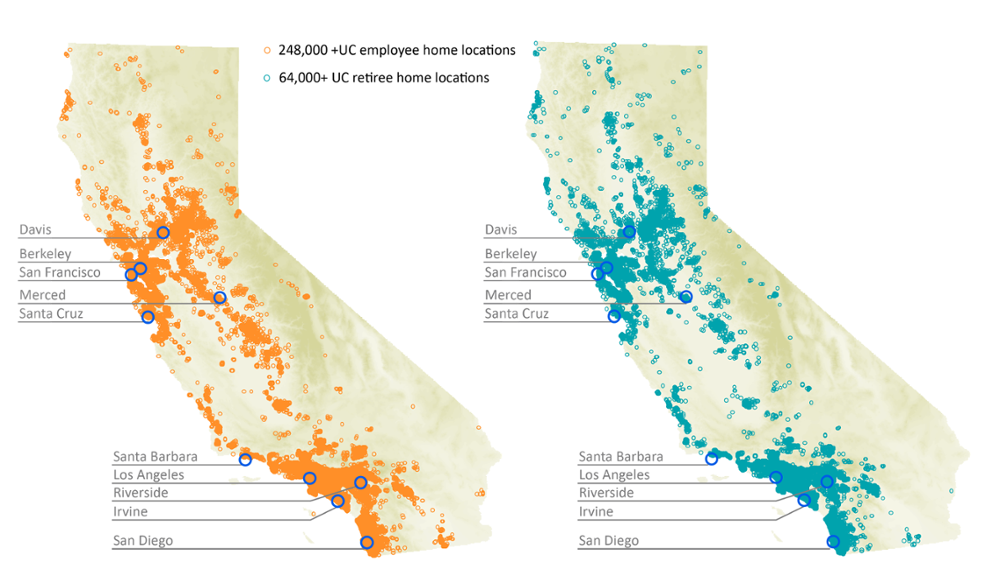Part of the UC mission
Along with teaching and research, UC contributes to the well-being of the state’s population and economic growth through its public service efforts. UC’s impact goes well beyond its on-campus activities. UC has a significant presence in nearly every community throughout California.
Every UC campus and UCOP’s Division of Graduate, Undergraduate and Equity Affairs (GUEA) administer hundreds of thousands of community-based programs across a range of foci, from community and social services to teacher professional development and K–12 student services. UC Agriculture and Natural Resources (UC ANR) and the UC Natural Reserve System (NRS) support sustainable agriculture, environmental stewardship, healthy families, and education.
UC Agriculture and Natural Resources
UC Agriculture and Natural Resources (UC ANR) implements the land-grant mission for the University, which emphasizes the development and dissemination of practical information to address critical agricultural, environmental and societal issues. The land-grant system represents a three-way partnership with federal, state and county governments.
More information about the land-grant system.
UC ANR statewide network and impacT
UC ANR operates a statewide network of researchers and educators which includes the multi-campus Agricultural Experiment Station and statewide Cooperative Extension. There are approximately 540 Agricultural Experiment Station researchers currently located at three campuses. In 2022, President Michael V. Drake announced formally adding UC Santa Cruz and UC Merced to UC’s Agricultural Experiment Station, joining UC Berkeley, UC Davis, and UC Riverside. There are over 110 Cooperative Extension Specialists, located at six campuses, Research and Extension Centers (RECs), and county offices, and 150 Cooperative Extension Advisors conducting research, outreach, and education in all 58 California counties. Nine statewide RECs provide education for the public and places for researchers to conduct field experiments. UC ANR is often the face of the University to Californians with no other connection to UC.
UC ANR people and programs connect and deliver resources from the entire UC system, forming integrated teams to work on complex issues and develop innovative, multidisciplinary, science-based solutions to improve the lives of all Californians. Several impact highlights from 2022 follow, illustrating how UC ANR benefits communities across the state in ways that contribute to President Drake’s priorities for UC. For more information on its breadth of impact see the 2022 UC ANR Annual Report.
Leading on climate change
- The UC ANR Climate Smart Agriculture effort is a partnership with the California Department of Food and Agriculture that provides hands-on assistance to farmers and ranchers through grant application assistance, workshops, field days, and events. The program focuses on working with underserved producers and offers information in English, Spanish, Mandarin, Hmong, Cantonese, and Punjabi. Since 2019 almost $36M has been awarded to over 1,300 farmers and ranchers in 24 counties to implement science-based climate-smart practices that support climate change mitigation by reducing greenhouse gas emissions and sequestering carbon, and promote climate change adaptation by increasing on-farm resilience.
- UC ANR’s statewide California Naturalist Program promotes stewardship of the state’s natural resources through education and service. The program recently added Climate Steward certification courses. In the first two years of the program, Certified Climate Stewards conducted 4,838 service hours over 602 service activities, including community resilience and adaptation and climate justice activities. It is estimated that 1,412 tons of carbon emissions are reduced per year by Climate Steward participants.
Expanding opportunity and excellence
- UC ANR’s statewide 4-H Youth Development Program engages youth ages 5–18 in all 58 counties to reach their fullest potential while advancing the field of youth development. In 2022, there were 46,631 California youth enrolled. In a recent study on the long-term impacts of participation, 84 percent of the 695 UC 4-H alumni respondents reported the program helped them succeed in their careers later in life. Findings also show the program helped foster a sense of responsibility that lasted into adulthood. UC 4-H alumni reported volunteering 130 hours annually, compared to the general population’'s 57 hours annually, and 65 percent of 4-H alumni always vote, compared to 57 percent of the general population.
Strengthening an inclusive, respectful and safe community
- Research has found inequities in access to urban vegetation in communities that are more ethnically and racially diverse and have lower income levels. The UC Master Gardener Program extends to the public research-based information about food gardening and sustainable landscaping, which results in sustained and expanded school and community gardens. In 2022, there were close to 6,200 UC Master Gardener volunteers in 52 California counties.
- University of California Cooperative Extension (UCCE) provides resources to underserved groups in farming communities across the state. For example, in the Sacramento Valley region, UCCE collaborated with around 200 small-scale Hmong and Iu Mien farmers in 2022. Language and cultural barriers have previously prevented them from integrating into and receiving resources standard for other California farmers. UCCE worked with the Department of Pesticide Regulation to hire two staff persons, one Hmong and one Iu Mien speaker, to develop a culturally targeted outreach program, which resulted in increased reach. UCCE also brought representation of the Iu Mien strawberry farmers’ needs to the industry, which resulted in a collaboration with the UC Strawberry Breeding Program that ultimately distributed improved varieties to the Iu Mien farmers.
Promoting health in California’s vulnerable communities
- The California Expanded Food and Nutrition Program (EFNEP) delivers research-based nutrition education to limited-resource families with young children to improve healthy lifestyle choices in 19 California counties. In 2022, EFNEP graduates statewide saved an average of $33.58 in their monthly grocery budgets, which is $400 in savings per year for each family. After completing EFNEP classes, the number of participants reporting they were unable to afford balanced meals decreased from 90 percent to 33 percent.
- The CalFresh Healthy Living, University of California Program (CFHL, UC) is a joint agreement with UC, USDA, and the California Department of Social Services to serve persons eligible for the federal Supplemental Nutrition Assistance Program (SNAP). The program is delivered by UCCE in 34 California counties. CFHL, UC reported Policy, Systems, and Environment (PSE) changes at 286 SNAP-Ed sites statewide, contributing to improved community health and wellness for more than 108,000 people. For example, 111 program sites in 19 counties made at least one physical activity-related PSE change, and more than half of these sites improved the quality and/or number of opportunities for structured physical activity. In addition, the program provided evidence-based nutrition and physical activity education to 54,700 children from preschool through 12th grade.
Graduate, Undergraduate and Equity Affairs programs
Graduate, Undergraduate and Equity Affairs (GUEA) provides leadership and support for efforts that advance UC equity and inclusion, that promote access to and successful completion of baccalaureate and graduate degrees, and that help to provide an exemplary student academic experience. GUEA’s Outreach and Educational Partnerships supports and helps UC sustain partnerships with K–20 public education segments, community-based organizations, and the business sector. These collaborations advance college preparation, access, and degree-completion for students from underserved backgrounds.
Educational partnerships
The University of California’s Student Academic Preparation and Educational Partnerships (SAPEP) programs help prepare California students for higher education (10.2.1). SAPEP programs served nearly 130,816 K–12 students at 1,511 public schools, and 16,621 community college students at 109 community colleges in 2020–21, the most recent year available.
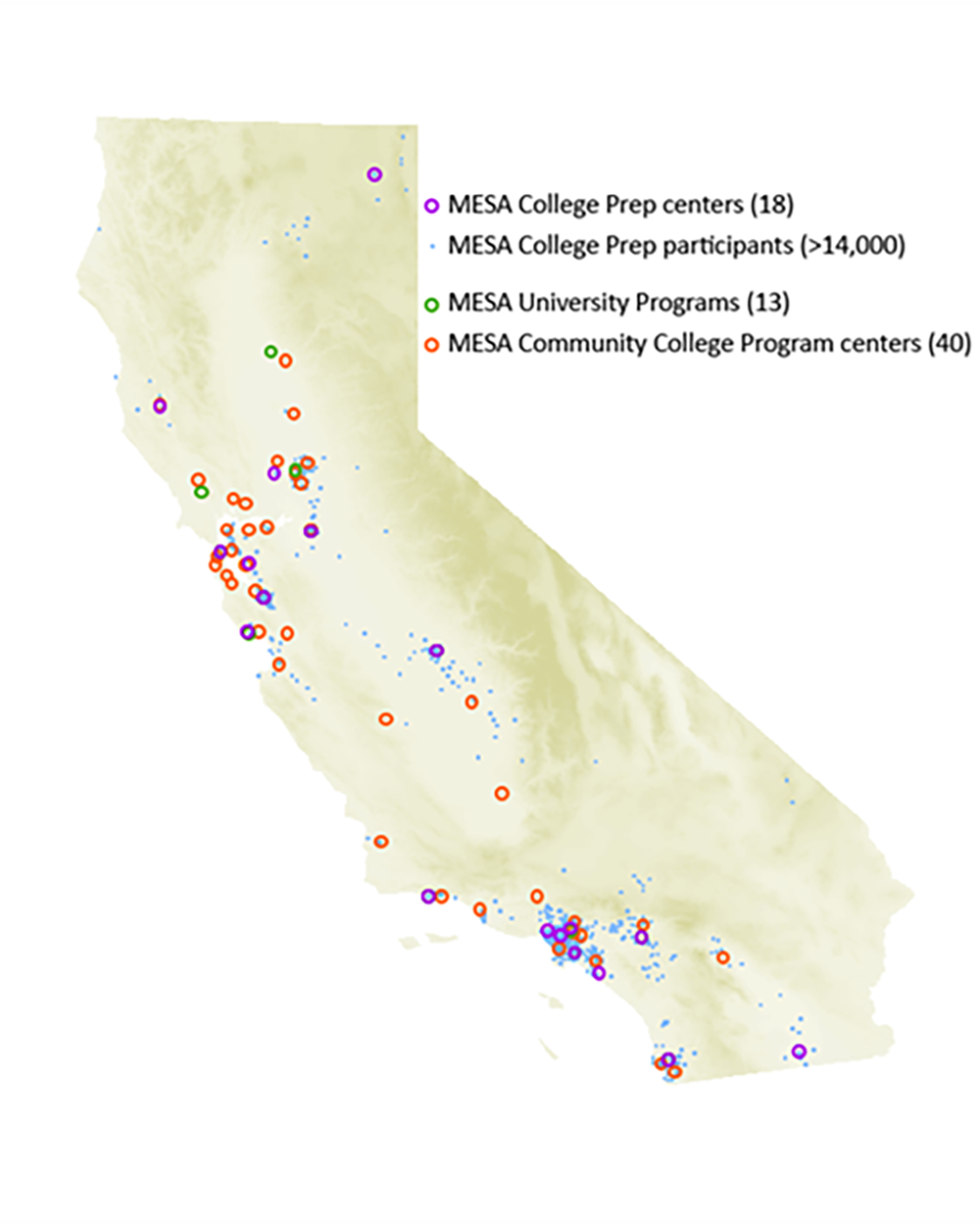
The goal is to promote achievement by supporting academic preparation and college readiness. Programs include the Early Academic Outreach Program (EAOP), which focuses on “a–g” course completion (a prerequisite for admission to UC and CSU); K–20 Regional Intersegmental Alliances (aka P–20), creating ties between campuses, schools, local communities, and business organizations; The Puente Project, focusing on college-preparatory English skill development; Transfer Prep, focusing on community college transfer support; and Mathematics, Engineering, Science Achievement (MESA), focusing on STEM (science, technology, engineering, and mathematics) skills development. he Mathematics, Engineering, Science Achievement (MESA) program integrates UC’s core missions of teaching and public service by focusing on the academic preparation of students at K–12 schools, community colleges, and four-year universities. Through its three components — the MESA College Prep Program (formerly known as MESA Schools Program or MSP), the MESA Community College Program (MCCP), and the MESA University Program (formerly known as MESA Engineering Program or MEP) — MESA serves more than 18,240 California students annually. (During the Covid pandemic, MESA saw a drop of around 6,000 students, primarily in the College Prep program, where middle school and high school students were most affected. Numbers began steadily rebounding as students returned to school, but have not yet reached pre-pandemic levels).
MESA College Prep centers are housed in 18 locations and serve more than 9,456 students at about 371 K–12 schools. Centers offer classes that reinforce math and science content standards. MESA activities include workshops aimed at strengthening study skills, monitoring progress, and encouraging students to pursue degrees in STEM.
The MESA Community College Program (MCCP) manages 85 centers at community colleges, serving 3,481 students annually. These centers provide academic excellence workshops, orientation courses, academic advising, and counseling activities to help community college students transfer to a four-year university in a timely manner.
The MESA University Program operates 19 centers located in public (UC and CSU) and private universities across the state. Serving 5,303 students annually, these centers assist college students in attaining four-year degrees in engineering and computer science by providing tutoring and academic skills workshops. In partnership with local industry leaders, MESA University Program centers also provide career and professional development opportunities for students.
UC also plays an important role in preparing California’s teacher workforce. UC’s Teacher Education Programs prepare teacher candidates to engage students in rigorous, relevant, and inquiry-based educational experiences. Located at eight UC campuses, Teacher Education Programs recruit, prepare, and support educators who are committed to academic excellence, equity, and integrity, and to cultivating the highest levels of achievement and opportunity for all students.
UC also provides ongoing support to educators already in the workforce through professional development programs. For example, the California Subject Matter Project (CSMP) is a network of nine discipline-based statewide projects, providing more than 700 professional development events for educators at more than 2,500 schools each year. CSMP professional learning opportunities are aligned with state-adopted standards and are collaboratively designed by K–12 and university educators to enhance learning for all students (10.2.1).
Social and economic impact
Including the programs of ANR and UC’s educational partnerships mentioned above, the University of California administers community-based programs at more than 20,000 locations across the state. UC in California; Impact beyond campus borders, displays these programs on an interactive website. Because the well-being of every California citizen and community is important, all campuses sponsor and manage programs far from their campus locations (10.3.1).
Critical to the success of the University is a shared understanding with the California Legislature and California public of the enormous benefit UC provides to the state; its social and economic impact can be demonstrated with the UC in California maps (10.3.2).
More than 1.2 million UC alumni are known to live and work in California (10..3.3). They are leaders, volunteers, and contributors to the vitality of the state’s communities, businesses, and culture. UC’s operations also add significantly to the state’s economy. With over 251,000 employees, UC is California’s third-largest employer (10.3.4). True to its land-grant mission, the UC system touches many aspects of life in California. The UC public service mission has evolved in tandem with the changing needs of our state and local communities, and has developed programs and partnerships that improve the lives of all Californians.
